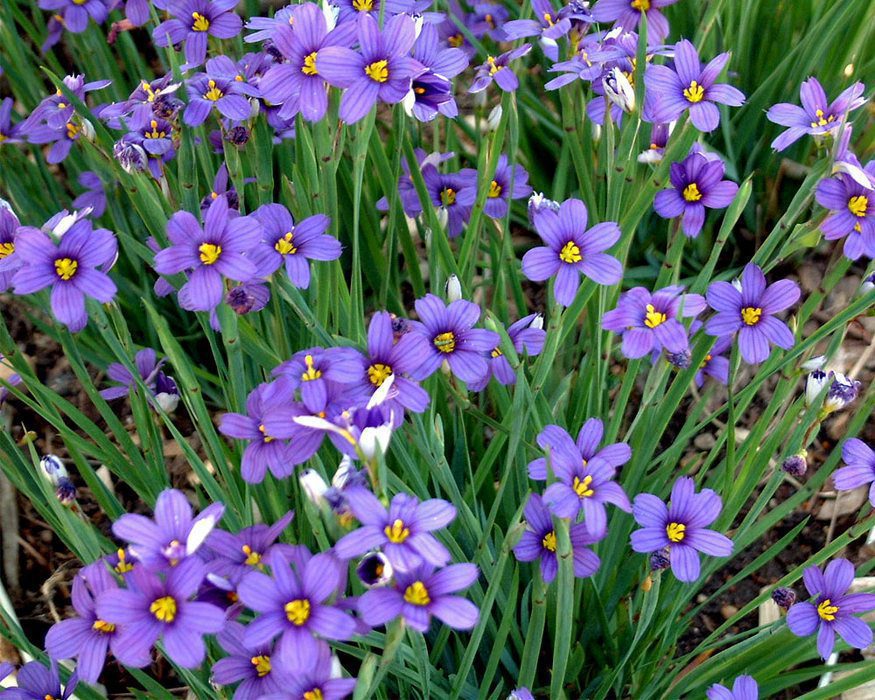Blue-Eyed Grass
Narrowleaf blue-eyed grass is not a grass as its name suggests, but rather a petite member of the iris family.
This Florida native has found its way into moist turf areas along Florida’s roadways in such large numbers that motorists notice a blue tinge in grass medians, even at 70 mph!
When not in bloom, this wildflower has narrow, bunched grasslike leaves that can quickly go unnoticed.
In nature, it may be found in moist meadows and open woodlands in the Eastern half of the United States and Canada.
It may reach a height of 18 inches and grows in clumps about 12 inches across. Narrowleaf blue-eyed grass thrives in full sun, and its flowers remain closed until the sun’s warm rays hit them.
Landscape Border Plant
This plant is excellent as a border for landscape beds, and while it is usually bright blue, it can be purchased in various colors ranging from deep purple to light pink.
It will do best in moist low-lying areas but will tolerate drier locations as well. Blue-eyed grass has very few pests or diseases.
Gardeners searching for plants suitable for the margins of ponds and ditch-banks should consider blue-eyed grass, a diminutive, native perennial that thrives in moist, sunny locations.
An iris relative, blue-eyed grass (Sisyrinchium angustifolium) features grass-like foliage and springtime flowers in shades of blue.
Growing Blue-Eyed Grass
This charming wildflower grows actively from mid-autumn to late spring but sits still during the heat of summer.
On suitable sites, blue-eyed grass self-sows prolifically. Once established, little care is required except for removing weeds and, if desired, autumn trim to remove summer-scorched leaves.
Same way as the other irises, blue-eyed grass slowly spreads outwards by forming “pups” off of the main leaf cluster. Mature plants form a clump of foliage 12 to 28 inches across and 6 inches tall.
Clusters benefit from periodic division, and old plants may develop a “bald spot” in the center.
Since it grows from a kind of bulb called a corm, it can survive periodic drought but rot if it remains sodden for too long or is heavily mulched. It is salt tolerant and grows well on barrier islands and coastal gardens.
The little star-shaped flowers rise on stiff stalks, which may stand a foot or so above the leaf mass.
Single flowers are open for only about a day, but multiple flowers are produced on the same stalk blooming one after another for several weeks, and one stalk can have multiple flowers open at the time.
Blooming Period
In our area, this plant may bloom for up to six weeks in the early spring. Blue-eyed grass may be propagated from seed, but it is easier to divide a clump using a sharp-edged spade.
Although it prefers moist soils, blue-eyed grass can be grown in most Florida landscape settings.
Use this plant along walkways and the planting bed edges, plant it in mass, or scatter it through a wetland meadow. It is a satisfactory container plant too, but bear in mind the bloom period is shorter than annuals like petunias and marigolds.
Grouping blue-eyed grass with other flowering plants can extend the color, and the grassy foliage can add an attractive accent and be cut back to the soil level if it becomes shabby.
Blue-eyed grasses were once considered to be a complex group of species and subspecies, but most botanists now group native blue-eyed grass in Florida into a single species,
Sisyrinchium Angustifolia was found from Newfoundland and Quebec to southern Florida and west to eastern Texas.
Its native habitat is open woods, moist pinelands, fields, meadows, marshes, the edges of swamps, and grassy roadsides.




























Comments are closed.